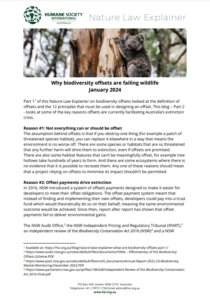One of the most important global meetings on wildlife trade has just wrapped up in Uzbekistan. It’s capital city Samarkand was where governments convened for the 20th Conference of the Parties (CoP20) to the Convention on International Trade in Endangered Species of Wild Fauna and Flora (CITES) to decide how international trade should be managed for some of the world’s most threatened...
Nature Law Explainer: Why biodiversity offsets are failing wildlife
Part 1 of this Nature Law Explainer on biodiversity offsets looked at the definition of offsets and the 12 principles that must be used in designing an offset. This blog – Part 2 – looks at some of the key reasons offsets are currently facilitating Australia’s extinction crisis.
Reason #1: Not everything can or should be offset
The assumption behind offsets is that if you destroy one thing (for example a patch of threatened species habitat), you can replace it elsewhere in a way that means the environment is no worse off. There are some species or habitats that are so threatened that any further harm will drive them to extinction, even if offsets are promised.
There are also some habitat features that can’t be meaningfully offset, for example tree hollows take hundreds of years to form. And there are some ecosystems where there is no evidence that it is possible to recreate them. Any one of these reasons should mean that a project relying on offsets to minimise its impact shouldn’t be permitted.
Reason #2: Offset payments drive extinction
In 2016, NSW introduced a system of offsets payments designed to make it easier for developers to meet their offset obligations. The offset payment system meant that instead of finding and implementing their own offsets, developers could pay into a trust fund which would theoretically do so on their behalf, meaning the same environmental outcome would be achieved. Since then, report after report has shown that offset payments fail to deliver environmental gains.
The NSW Audit Office, the NSW Independent Pricing and Regulatory Tribunal (IPART), an independent review of the Biodiversity Conservation Act 2016 (NSW) and a NSW Senate Inquiry have all found that the NSW offset payment system has failed to deliver for nature and is actually driving biodiversity declines. In fact, the most recent IPART report recommended the offset payment system be phased out as quickly as possible. It’s therefore incredibly concerning that a system similar to the one operating in NSW is currently being considered by the Albanese Government as part of our reformed national environmental legislation.
Some of the key problems with offset payments are:
1) Making an offset payment – instead of delivering a direct offset – isn’t an offset at all. It can be considered a form of compensation for harm but it doesn’t guarantee a direct, quantifiable environment gain for the impacted species (see more on this in Part 1);
2) Payments can be made for species for which offsets simply can’t be found (i.e. habitat for many threatened species), meaning the environmental harm isn’t actually being compensated for. Indeed, one reason often used for allowing offset payments is because developers are finding it hard to find offsets for some species and ecological communities. In those cases it’s time to say no to the developments;
3) There is often significant lag between an offset payment being made and an offset being delivered (a problem currently seen in the NSW offset market), which means more environmental harm is done than what was considered in the development application; and
4) Developers often buy offsets in offset ‘markets’ which introduces many other problems (more on this below).
Reason #3: Offset markets haven’t worked
Offset markets provide a way to link developers who need to find offsets with people who are willing to provide them. Unfortunately, what we’ve seen is governments intervening in the ‘market’ and undermining environmental outcomes in order to make the market more attractive to developers, thereby helping governments to claim there is a successful market.
This has meant that the prices for offsets have been reduced so developers don’t consider them to be too expensive, which completely undermines the purpose of offset markets – i.e. using a price signal to encourage developers to avoid areas of high biodiversity value. It also means landholders who are offering to provide offsets are given far too little income to ensure that environmental values can be delivered in a way that will last forever.
There is more information on the failing of offset markets in the independent reviews linked above in Reason #2.
Reason #4: Offsets can’t solve the extinction crisis
Restoration and offsets should not be confused. As described in Part 1 of this Nature Law Explainer, biodiversity offsets are quantifiable biodiversity outcomes designed to compensate for adverse and unavoidable impacts of projects. They are considered a measure of last resort. Fundamentally, offsets are about compensating for harm by attempting to maintain the status quo. Even if an offset requires some form of ‘net gain’, an offset only happens when a negative environment impact has been approved elsewhere.
In contrast, restoration recognises the need to repair past damage and restore our environment, without permitting additional harm. Restoration is an overarching term that captures an intent to return something to a prior condition, whether it’s a species, population or ecosystem. Ecological restoration refers to the process of assisting the recovery of an ecosystem that has been degraded, damaged or destroyed.[1]
In consequence, offsets are something that occur as part of a development assessment and decision-making process – developments must offset the harm that they are approved to cause. If we are going to stop the extinction crisis we need to do more than compensate for new harm, we must protect and restore the biodiversity we have left as well as restore what we have already lost.
Protecting and restoring biodiversity must be the key focus for our new nature laws.
[1] For more information on restoration see the National Restoration Standards at: https://www.seraustralasia.com/standards/NationalStandards2_2.pdf
Download a PDF version of this blog, so you can print and share with your Member of Parliament.
Learn more about what we need to achieve stronger laws for Australian nature. Read our other Nature Law Explainer blogs:



